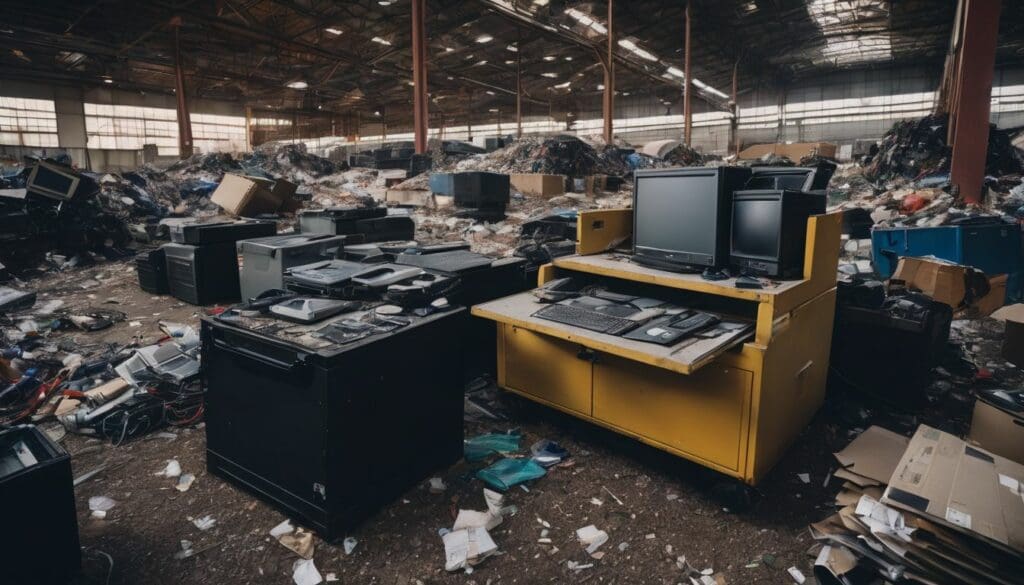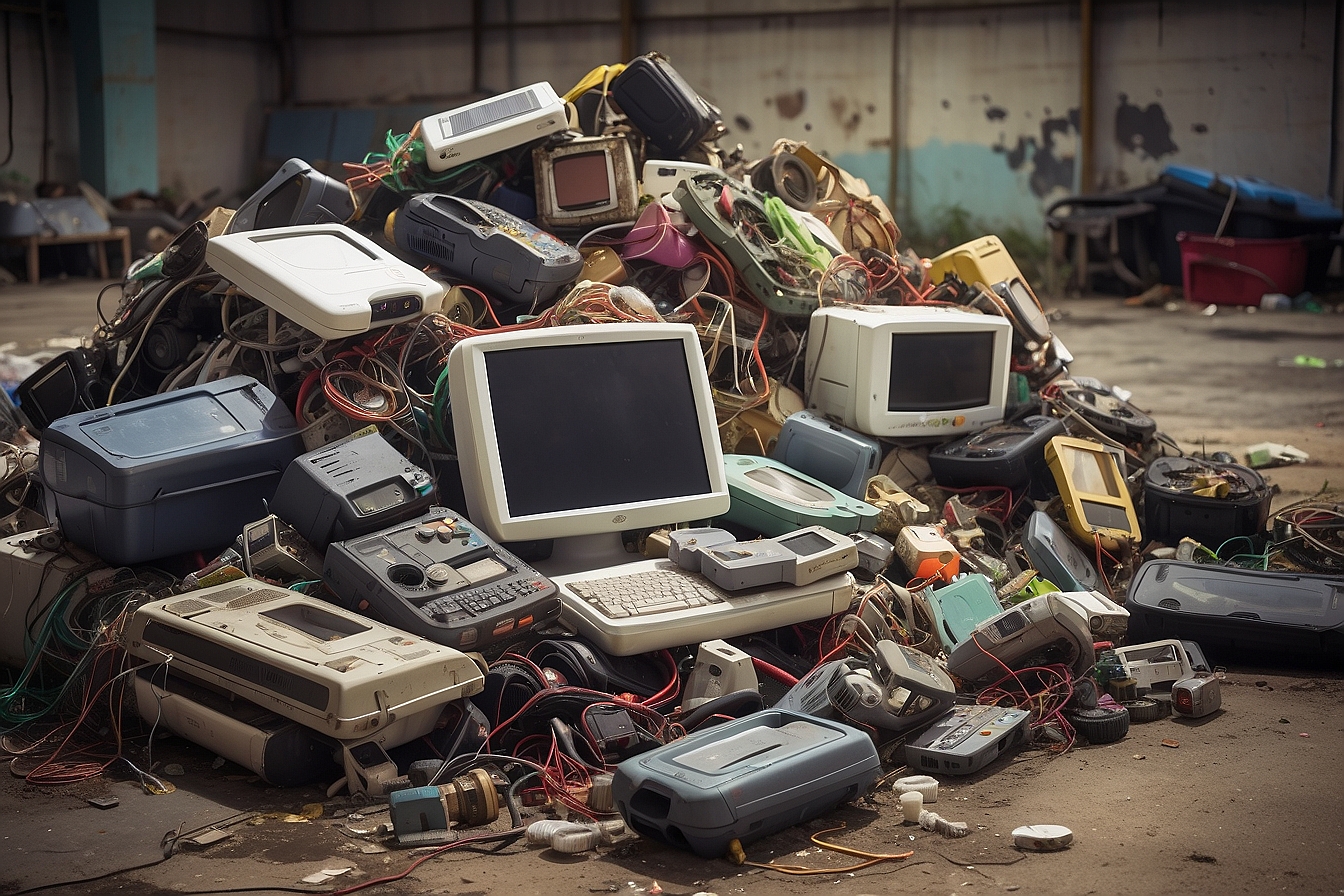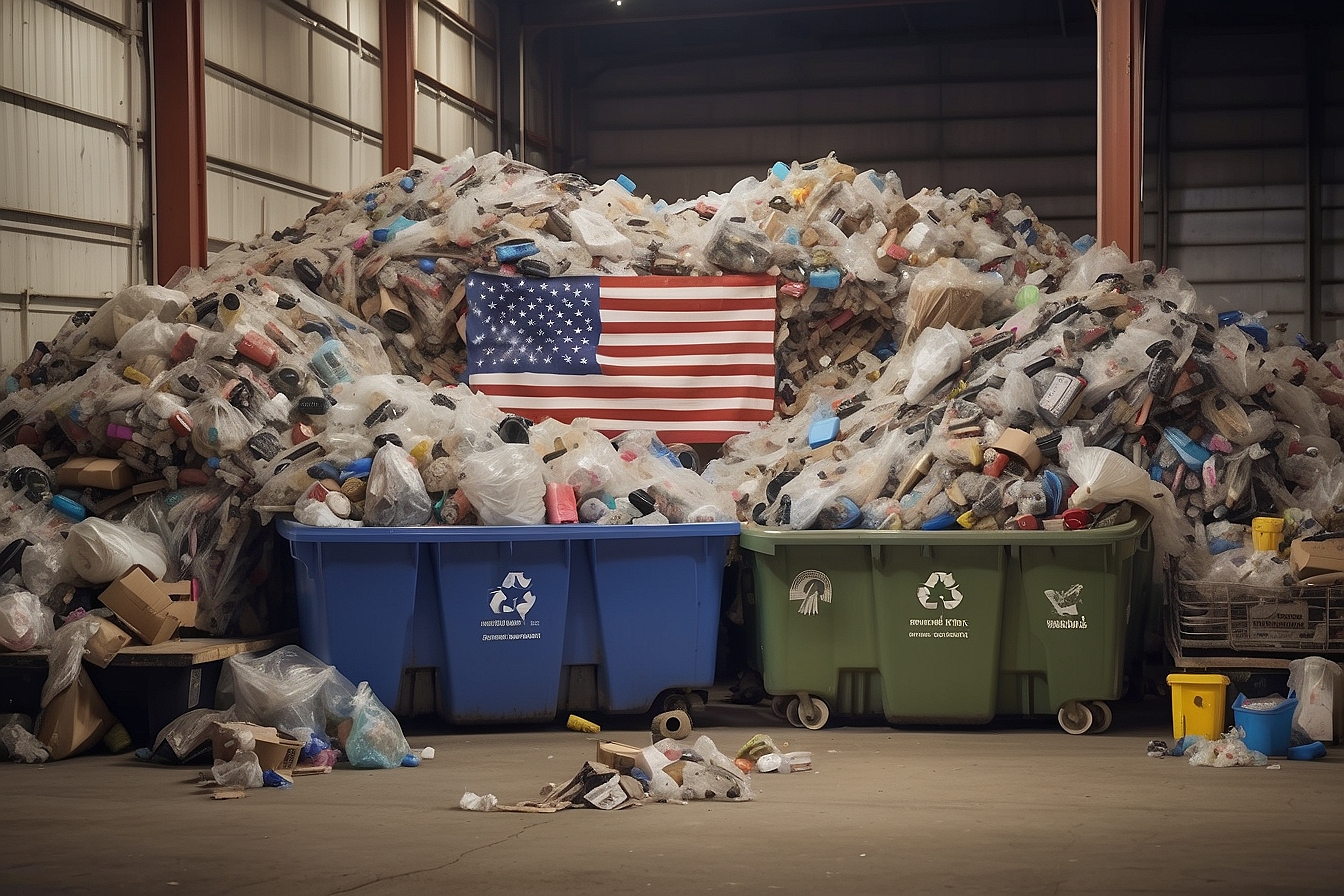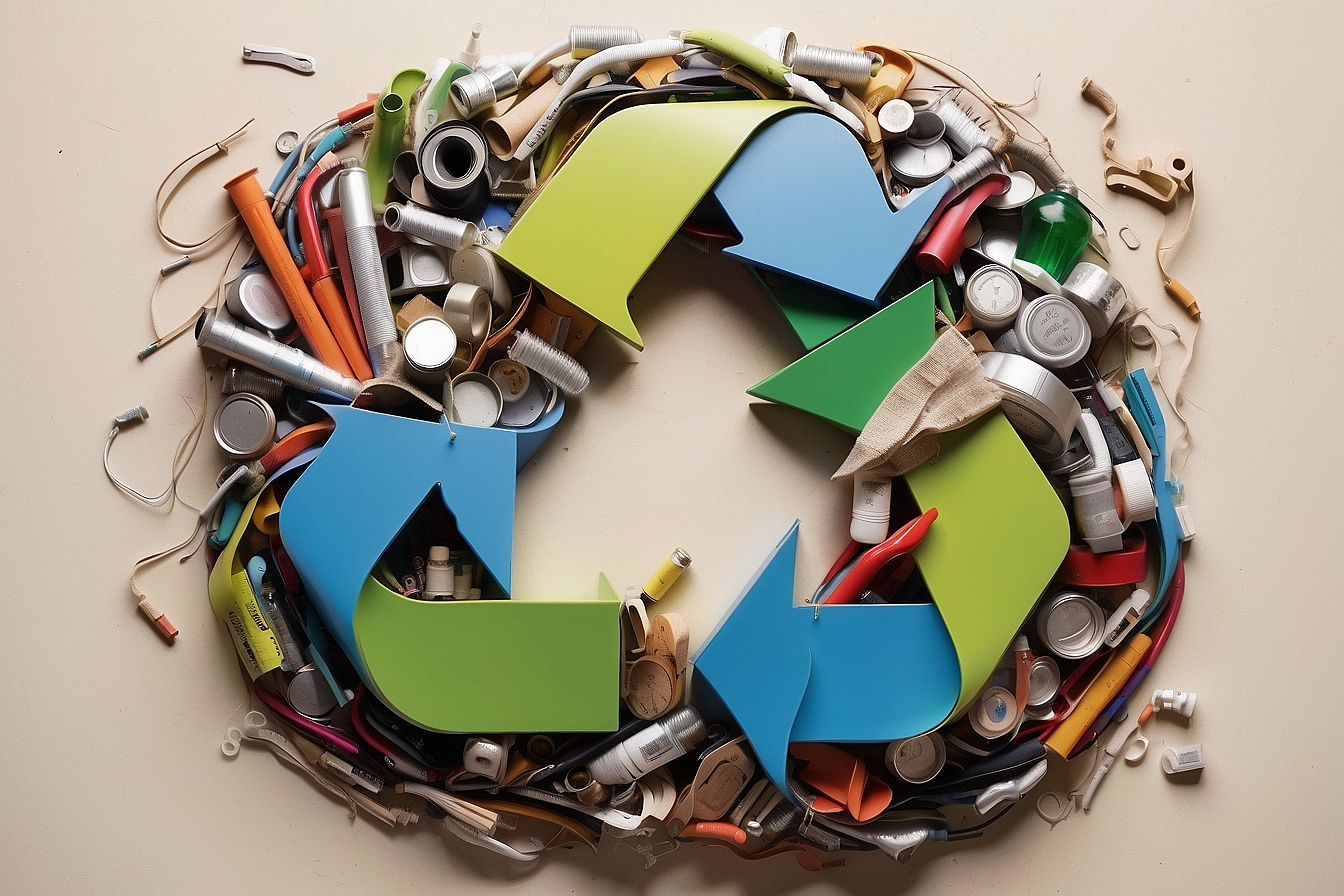We’ve all encountered the rather pesky problem of what to do with our old electronic devices – those that have given up the ghost or simply been surpassed by newer models. It’s a familiar challenge, particularly when you consider the staggering 50 million tonnes of e-waste generated globally every year.
In our meticulously crafted guide, we shall navigate through this maze of inconvenience and offer you carefully chosen advice on how to recycle your electronic waste in an environmentally friendly fashion.
So, let us roll up our sleeves and delve into some green-minded solutions together!
Key Takeaways
- Recycling electronic waste reduces environmental impact and conserves natural resources by extracting valuable materials like copper, gold, and silver.
- Raising awareness through campaigns and education is crucial to improving e – waste management practices among individuals and communities.
- Investing in recycling infrastructure will enable more effective processing of e-waste, preventing harmful substances from polluting the environment.
- Uniform regulations are needed for consistent e-waste management across different regions to streamline recycling processes and reduce operational complexities for businesses.
- Emphasising the importance of reducing, reusing, repairing, and recycling electronics helps create a circular economy that minimises resource depletion.
Challenges of E-Waste Recycling
The challenges of e-waste recycling include the complexity of electronic products, efficiency in recycling processes, limited infrastructure and awareness, material contamination, and the lack of uniform regulations.
These obstacles make it difficult to manage and properly dispose of electronic waste in a sustainable manner.
Product complexity
Modern gadgets come packed with an array of components, making electronic waste recycling a tough nut to crack. We face a maze of metals, plastics and other materials intertwined in every device we aim to recycle.
Smartphones, laptops and TVs crisscross circuit boards with precious metals like gold and silver alongside less valuable – but equally important – materials such as copper and aluminium.
Our task deepens as each product boasts its unique blend of components, often glued or soldered together, hindering easy separation. This complexity means standard recycling methods fall short; they’re not designed for the intricate disassembly required by contemporary electronics.
As we move forward to tackle process efficiency challenges next, understanding this nuanced difficulty underscores the need for innovative solutions in sustainable electronics lifecycle management.
Process efficiency
To improve electronic waste recycling, we must enhance process efficiency. Enhancing the sorting and disassembly processes can streamline operations and boost overall productivity.
By investing in advanced technology, such as robotics and automated systems, we can increase the speed and accuracy of separating valuable materials from e-waste. This will help to minimise waste and maximise resource recovery, contributing to a more sustainable electronic waste management system.
Focusing on process efficiency is crucial for achieving our environmental goals. It allows us to handle larger volumes of e-waste effectively while ensuring that valuable resources are recovered in an efficient manner.
By optimising the recycling process, we can contribute significantly to reducing the environmental impact of electronic waste disposal.
Moving forward, it’s essential to explore innovative solutions for enhancing process efficiency – driving towards a sustainable future where electronic waste is managed responsibly and effectively.
Limited infrastructure and awareness
To address the challenge of limited infrastructure and awareness, we need to prioritise investment in recycling facilities and collection points. Raising public awareness about the importance of responsible e-waste disposal is crucial.
This can be achieved through educational campaigns, community workshops, and partnerships with local authorities and businesses. By increasing accessibility to recycling facilities and promoting awareness among consumers, we can significantly improve electronic waste management practices.
Implementing effective e-waste recycling programmes at a grassroots level will play an essential role in reducing environmental impacts. Building sustainable infrastructure for proper disposal and processing of electronic waste is vital for creating a circular economy that minimises resource depletion and pollution.
Material contamination
Electronic waste is often contaminated with hazardous materials such as lead, mercury, and cadmium. These substances can leach into the soil and water, posing significant risks to human health and the environment.
It’s essential to handle e-waste carefully to prevent these harmful materials from polluting our surroundings further.
Contaminated electronic waste requires proper handling during recycling to avoid releasing toxic substances. Separating contaminated materials from non-contaminated ones in e-waste stream is crucial for effective recycling processes.
Lack of uniform regulations
Problems arise due to the absence of consistent guidelines for managing electronic waste. This inconsistency leads to confusion and hinders effective e-waste management as there is no standard approach in place across different regions.
Consequently, this can result in improper disposal, causing environmental harm and health risks for communities. Furthermore, it also creates challenges for businesses that operate across multiple locations as they must adhere to varying regulations which increases operational complexity.
Inconsistencies in regulations obstruct the development of a cohesive framework for addressing e-waste concerns and limit the effectiveness of sustainable initiatives. Uniform regulations are essential to provide clarity and guidance, enabling streamlined processes and promoting responsible electronic waste management at both local and global levels.
Solutions to E-Waste Problems
One solution to e-waste problems is implementing formal and informal e-waste recycling programmes to properly dispose of electronic devices. Another solution is promoting the concept of reducing, reusing, repairing, and recycling electronic products to minimise environmental impact.
Recycling
- We can recycle electronic devices by dropping them off at designated collection points or arranging for pick-up services.
- Recycling centres disassemble the devices, sort the materials, and extract valuable components like copper, gold, and silver for reuse.
- Proper recycling ensures that hazardous substances in electronics, such as lead and mercury, are safely disposed of, preventing pollution.
- Choosing products made from recycled materials helps close the loop, promoting a circular economy and reducing the demand for new resources.
- Supporting e – waste recycling initiatives and companies that prioritise responsible disposal practices encourages sustainable electronic product design.
Education
Education plays a crucial role in addressing the challenges of electronic waste. Here are some solutions through education to mitigate the impact of e-waste:
- Promoting awareness through school programs, workshops, and community events to educate people about the environmental impacts of electronic waste.
- Integrating e – waste management and sustainability into educational curriculums to instill responsible disposal habits from an early age.
- Collaborating with industry experts to provide training and certification programs for professionals in e-waste management and recycling technologies.
- Engaging in public awareness campaigns via social media, television, and other communication channels to inform individuals about the importance of proper e-waste disposal.
- Supporting research initiatives focusing on developing innovative solutions for managing electronic waste sustainably and efficiently.
- Encouraging active participation in local clean – up drives and recycling initiatives to reduce the accumulation of electronic waste in landfills.
Formal and informal e-waste recycling
To address the challenges posed by e-waste, it is crucial to consider both formal and informal recycling methods. Formal e-waste recycling involves regulated processes carried out by certified facilities, ensuring that electronic devices are dismantled, separated, and recycled in an environmentally responsible manner.
On the other hand, informal e-waste recycling encompasses practices such as scavenging for valuable materials from discarded electronics in unregulated settings. While formal recycling ensures compliance with environmental standards and worker safety, informal recycling often leads to hazardous exposure and environmental pollution due to improper handling of electronic waste.
Both approaches play a role in managing e-waste; however, supporting formal recycling channels can significantly reduce the negative impacts associated with improper disposal.
Furthermore, embracing formal e-waste recycling not only mitigates environmental harm but also supports sustainable resource management. Additionally, promoting access to formal e-recycling facilities helps raise awareness about responsible disposal practices among consumers and businesses alike.
This proactive approach fosters a culture of accountability towards electronic waste management while contributing to the conservation of valuable resources and reducing the environmental footprint of discarded electronics.
Reducing, reusing, repairing, and recycling
Conclusion
In conclusion, tackling the challenges of electronic waste recycling requires a concerted effort from individuals, businesses, and governments. Embracing sustainable practices such as reducing, reusing, repairing, and recycling electronic products can significantly mitigate environmental impacts.
Education and formal e-waste recycling initiatives are crucial in creating widespread awareness and promoting responsible disposal. By working together to address these issues, we can pave the way for a greener and more sustainable future for generations to come.
FAQs
1. What are the main challenges of recycling electronic waste?
The challenges of electronic waste recycling include managing hazardous materials, preventing environmental impacts, and overcoming difficulties associated with disposal and e-waste management systems.
2. Why is it important to recycle electronics responsibly?
Responsible electronic waste disposal helps control pollution, reduces the environmental impact of e-waste, and supports sustainability by conserving resources used in electronics production.
3. How can we reduce electronic waste?
Reducing electronic waste involves promoting electronics sustainability through initiatives like designing durable products, encouraging electrical waste reduction at the source, and implementing sustainable e-waste solutions.
4. What technologies help with recycling e-waste?
Recycling technology plays a crucial role in processing e-wastes by providing advanced methods to recover valuable materials and ensure effective hazardous waste disposal for better environmental sustainability.
5. Can anyone participate in e-waste recycling initiatives?
Yes! Everyone can contribute to sustainable development by participating in local e-waste recycling initiatives that promote responsible resource conservation and prevent harmful e-waste pollution.





